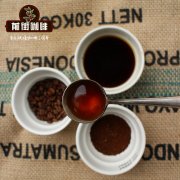The type of coffee beans is one of the most famous high-quality Arabica coffee beans indispensable conditions

Professional coffee knowledge exchange more coffee bean information please follow the coffee workshop (Wechat official account cafe_style)
Qianjie-Arabica variety introduction
The planting conditions of "Arabica" coffee are relatively stringent, requiring higher elevations (6 to 2000 meters above sea level), fertile soil fertility, adequate moisture, proper sunshine conditions and shade. "Arabica" coffee species are less resistant to diseases and insect pests and are vulnerable to damage.
In addition, the yield of coffee trees per unit area of Arabica is also low. At present, "Arabica" coffee accounts for 75% of the world's coffee production, and of these "Arabica" coffee production, only 10% of Arabica coffee quality can be classified as "boutique coffee (Specialty Coffee)."
Arabica coffee has a varied and broad potential flavor. Arabica coffee produced in different regions, different elevations and different climates usually has its own characteristics and can show a completely different flavor. "Arabica" coffee smells like grass when it is not roasted. After proper roasting, it shows "fruity" (medium-light roasting) and "caramel sweetness" (deep roasting). Generally speaking, it has a better aroma and flavor than Robusta beans.
High-quality Arabica coffee requires complicated manual picking, selection and meticulous processing, so the world's most expensive and best coffee beans are Arabica coffee.
In addition to varieties, coffee beans are judged by origin and grade. But even in the same country, there are advantages and disadvantages of coffee beans in different producing areas. Taking Ethiopia, the origin of Arabica coffee beans, for example, the whole territory can be divided into nine major coffee producing areas, including five boutique coffee areas: Sidamo, Yegashefi, Harald, Lim, Lekampudi, and four general commercial bean producing areas: Gemma, Illu Gbagbo, Tibby and Becca.
Ethiopia is the origin of Arabica coffee beans. Ethiopian coffee, which grows in the natural wild environment, is called "wilderness coffee". It retains the most primitive and natural taste of coffee beans and has the most direct and full expression of the soil. Among them, Sidamo and Yega Xuefei are the most outstanding. Yega Xuefei originally belonged to the sub-region of Sidamo, but it was independent because of its special flavor.
Lightly baked Yega Chuefei has unique sweet aromas of lemon, flowers and honey, soft acidity and citrus flavors, fresh and bright on the palate. It became an international hit almost overnight, became the target of experts, and has now become synonymous with Ethiopian boutique coffee.
Knowledge: Robusta is planted below 800 meters above sea level. Robusta has strong adaptability and strong resistance to diseases and insect pests.
In short: Qianjie is a coffee research hall, happy to share the knowledge about coffee with you, we share unreservedly just to make more friends fall in love with coffee, and there will be three low-discount coffee activities every month. The reason is that Qianjie wants to make more friends drink the best coffee at the lowest price, which has been Qianjie's tenet for 6 years!
END
Important Notice :
前街咖啡 FrontStreet Coffee has moved to new addredd:
FrontStreet Coffee Address: 315,Donghua East Road,GuangZhou
Tel:020 38364473
- Prev

How to distinguish Arabica coffee beans by their appearance
Professional coffee knowledge exchange more coffee bean information please follow the coffee workshop (Wechat official account cafe_style) front street-Arabica variety introduction Arabica, (scientific name Coffee arabica, English Coffee Arabica), also known as Arabica coffee, is Ethiopia (Ethiopia) on the Abyssinia plateau (now the Ethiopian plateau)
- Next

Why do most coffee use Arabica? the reason for the strength of Arabica coffee beans.
Professional coffee knowledge exchange more coffee bean information please follow the coffee workshop (Wechat official account cafe_style) front street-Arabica variety introduction actually the boutique coffee shop has long disdained to promote Arabica, but more accurate to bean species, origin, production season, altitude, processing methods and so on. Beans: iron pickup, bourbon, SL28, SL34, rose, etc. These common beans are beans.
Related
- Beginners will see the "Coffee pull flower" guide!
- What is the difference between ice blog purified milk and ordinary milk coffee?
- Why is the Philippines the largest producer of crops in Liberia?
- For coffee extraction, should the fine powder be retained?
- How does extracted espresso fill pressed powder? How much strength does it take to press the powder?
- How to make jasmine cold extract coffee? Is the jasmine + latte good?
- Will this little toy really make the coffee taste better? How does Lily Drip affect coffee extraction?
- Will the action of slapping the filter cup also affect coffee extraction?
- What's the difference between powder-to-water ratio and powder-to-liquid ratio?
- What is the Ethiopian local species? What does it have to do with Heirloom native species?

